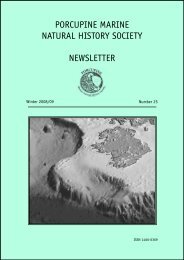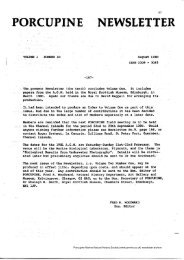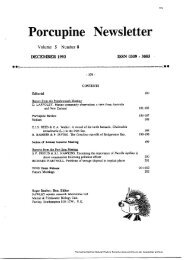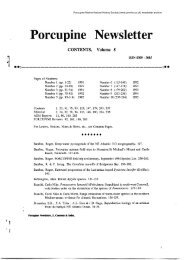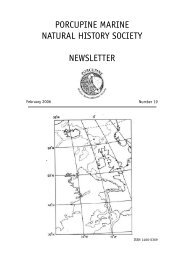PORCUPINE MARINE NATURAL HISTORY SOCIETY NEWSLETTER
PORCUPINE MARINE NATURAL HISTORY SOCIETY NEWSLETTER
PORCUPINE MARINE NATURAL HISTORY SOCIETY NEWSLETTER
Create successful ePaper yourself
Turn your PDF publications into a flip-book with our unique Google optimized e-Paper software.
FIELD REPORTS<br />
8<br />
Porcupine Society Field Trip<br />
28-30 th March 2008<br />
Inland Sea, Anglesey<br />
Paul Brazier p.brazier@ccw.gov.uk<br />
The sheltered waters of the Inland Sea, a<br />
stretch of sea lying between Anglesey and Holy<br />
Island, north Wales are quite unusual. The<br />
narrow strait is culverted at both the north<br />
and south ends, constraining the tidal flow<br />
and shifting the timing of the high and low<br />
tides relative to the open coast. Whilst the<br />
tide starts to flood at Holyhead (just round<br />
the corner), the Inland Sea continues to drain<br />
up until 2-3 hours after low water Holyhead<br />
– the equivalent of 3.5 metres above chart<br />
datum. The daily tidal range in this lagoonlike<br />
environment is only 1 metre, but the full<br />
tidal range is nearly 2m, accounting for the<br />
neap and spring tides. A full mathematical<br />
evaluation of the tidal regime in given in Hill<br />
(1994).<br />
South of Ynys Benlas - Paul Brazier<br />
The Inland Sea is a Site of Special Scientific<br />
Interest (SSSI) for its intertidal habitats<br />
(eelgrass beds, sediment flats) saltmarsh and<br />
birds, it is within the Ynys Mon (Anglesey)<br />
Area of Outstanding Natural Beauty (AONB)<br />
and is a local nature reserve. There are plenty<br />
of pieces of evidence around the shores that<br />
PMNHS Newsletter No.24 Summer 2008<br />
remind us of previous activities, including<br />
walls, dams and fencing; and of more recent<br />
activities such as fish netting and Pacific oyster<br />
farming.<br />
Access to the shores of the Inland Sea<br />
is limited to Four Mile Bridge and a public<br />
footpath that runs the length of the east<br />
side. Through the kind permission of Anglesey<br />
Aluminium, who own the western half of the<br />
Inland Sea, Porcupine members were able to<br />
access this rarely visited part, to appreciate<br />
the relatively undisturbed shores.<br />
Due to the enthusiastic turn out of<br />
Porcupine members and friends, three locations<br />
were visited in and around the Inland Sea. Ivor<br />
Rees took leadership of a team who headed<br />
south into the Cymyran Sound, to investigate<br />
some exceptionally sheltered inlets (SH 281<br />
780). Here, free living channel wrack Pelvetia<br />
canaliculata, bladder wrack Fucus vesiculosus<br />
and knotted wrack Ascophyllum nodosum ecad<br />
scorpioides live adjacent to and within the<br />
saltmarsh creeks. This habitat is not known<br />
from anywhere else in Wales and is typically<br />
associated, in the UK with Scottish sea lochs.<br />
This team subsequently dispersed northwards<br />
along a public footpath to investigate and<br />
record species along the eastern edge of the<br />
Inland Sea, north of Four Mile Bridge (SH 280<br />
784). Kathryn Birch and Julia Nunn were the<br />
primary recorders, collating the observations<br />
from boulders and muddy gravels by the<br />
other members of the team. Robin Shrubsole<br />
enthusiastically collected sediment samples<br />
and added further to the species list that was<br />
recorded in-situ. Tim Worsfold also collected<br />
washings of seaweeds and sediments from<br />
this team to subsequently work up back at<br />
the laboratory.<br />
Tim Worsfold in action - Paul Brazier



